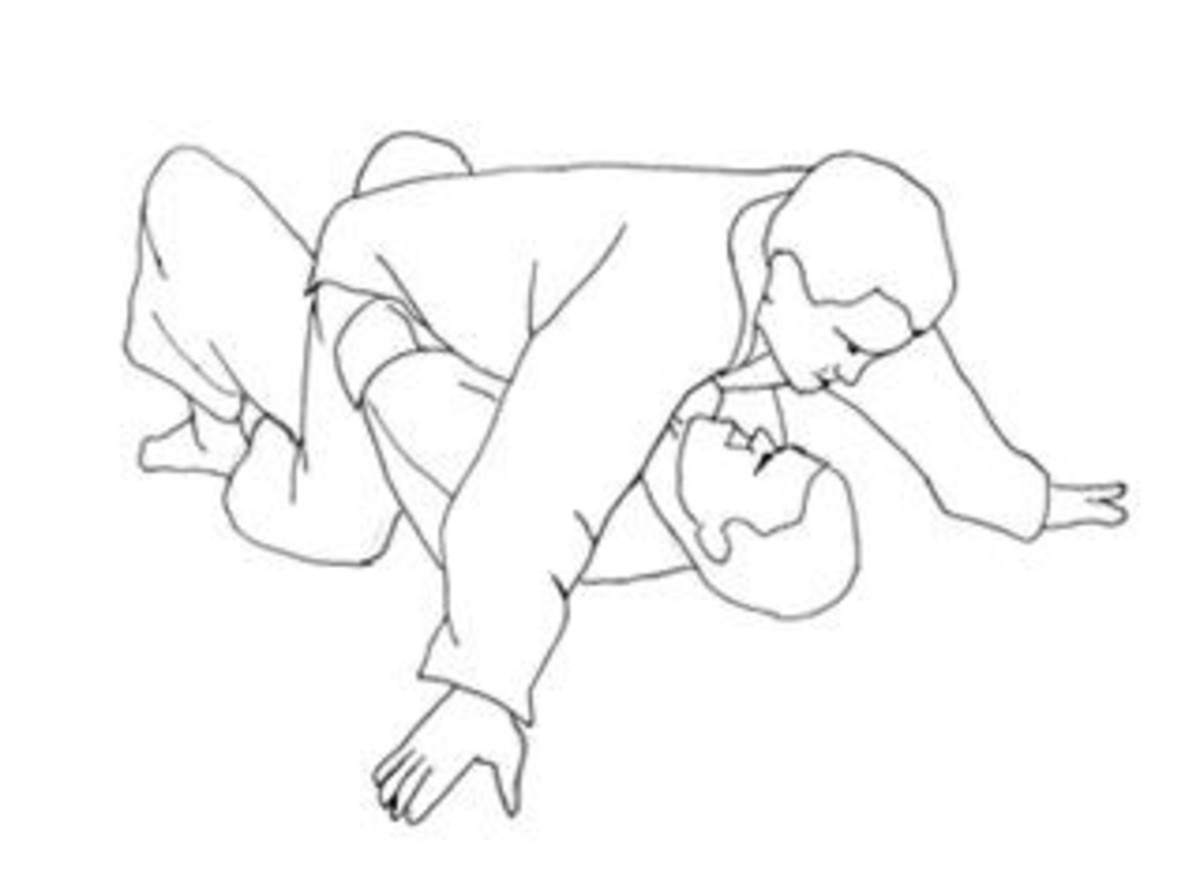Basic Equipment, Tips and Techniques for Beginning Rock Climbing
How hard could it be to climb a wall? Whether inside or outside, climbing is a fun sport that just about anyone can do. Here are some tips on how to do it.
A few years ago I participated in a weekend program sponsored by the Illinois Dept. of Natural Resources called Becoming an Outdoor Woman. The weekend was filled with activities to choose from including orienteering, cooking outdoors, canoeing, shooting a rifle or handgun, outdoor photography and many more. One of the activities I chose was rock climbing. Unfortunately, we weren’t able to climb that day but did get a chance to rappel down the side of the bluff.
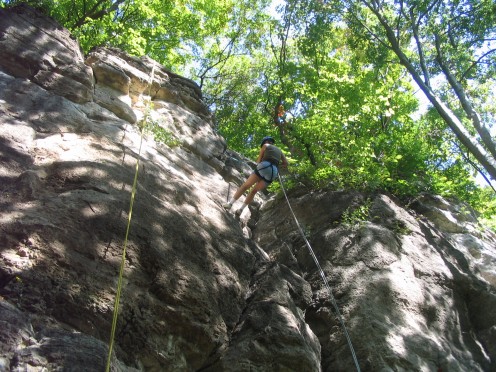
My younger son, Sam, has been an avid camper and hiker since he was in Scouts. Now attending Northern Illinois University, he also works with the recreation center on campus, leading groups on hiking, camping, and rock climbing trips. When he came home for Christmas break in 2011, I asked him to take me climbing so he and I headed out to Upper Limits in St. Louis.
We climbed for about two hours. That doesn’t seem like very long but it is if you're an inexperienced climber. I did most of the climbing and I found that I was getting pretty tired by the end of that time – not only because it’s physically demanding but also because it’s pretty stressful and nerve wracking trying to find the necessary hand and foot holds and managing any fears you have. The gym did have seven autobelays so Sam was able to do some climbing as well.
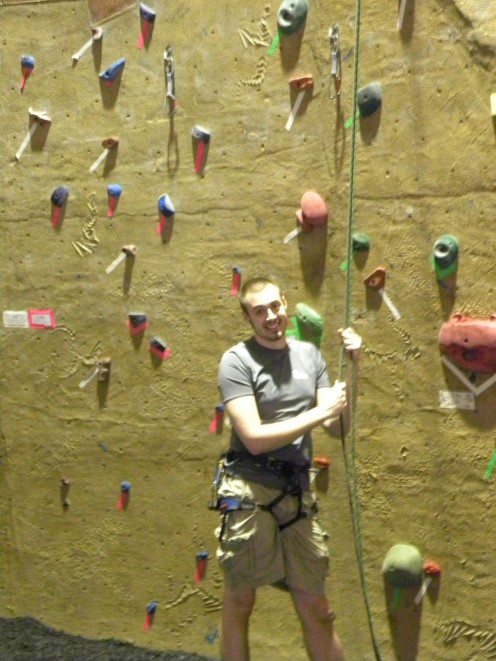
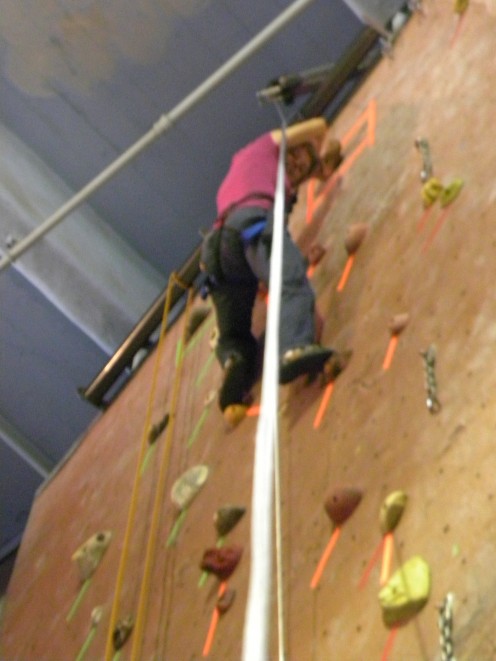
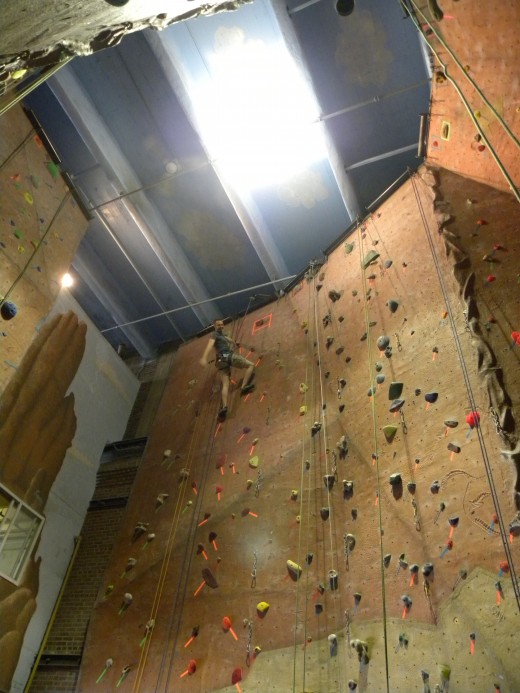
Equipment you need or is nice to have
As with any sport, there's basic and 'nice-to-have' equipment you need. Here's some Sam recommends.
- Climbing harness – a waist belt with leg openings. The harness supports the climber and costs between $30 and $80.
- Belay – a device used by the belayer (the person not climbing). It stops the rope or allows it to play out. There are a couple different types. One is made of two metal rings that look like a figure 8. A rope is passed through one ring, then around and under the other. The other type, the Air Traffic Controller (ATC) is the kind we used at Upper Limits. It has two holes just large enough to pass a loop of rope through. Costs range from about $17 to about $70.
- Climbing rope – These are not the traditional ropes that are made of three strands twisted together. These are made of continuous braided nylon fibers. Climbing ropes stretch a little under tension so a falling climber isn’t jerked suddenly as the rope stops him. A 165-foot long rope costs between $100 and $180.
- Helmet if climbing outdoors – like bike helmets, they should be snug and worn low over the forehead, not pushed back on your head. They cost about $60 and up.
- Climbing shoes – these types of shoes fit your foot more tightly so it doesn’t slide around inside the shoe. They have a stiff, smooth rubber sole and a more pointy toe so you can stick your foot into small cracks or crevices in the rock. A pair costs between $100 and $150.
- Clothing you can easily move around in. My son told me not to wear jeans but I didn’t have a problem maneuvering around in them. He wore shorts.
- Carabiners – these are very useful gadgets to hold your water bottle, chalk bag, maybe even sunscreen to your harness so they are on hand. They range between $5 and $20 and most are rated to hold about 2.2 tons.
- Chalk ball and bag – chalk is useful for keeping your hands dry. After climbing for 15 minutes or so and working up a sweat, it was nice to have the chalk on hand. Don’t do what I did. This chalk is in a bag and all you need to do is just gently pat it on your hands. If you overdo it, you’ll end up with chalk dust in your eyes like I did. Chalk balls are pretty cheap, around $4.50.
- Water bottle – as I said, you can really work up a sweat climbing so you want to stay hydrated.
Sam's Safety Tips
- Always wear a helmet if climbing outdoors
- Always double check your and your partner’s (if you have one) safety equipment
- Only climb with a belayer you trust
- Barefoot climbing may sound fun but if you’re climbing outside, expect to get cut. Blood doesn’t help increase your friction for climbing
Techniques and Advice
Here are a few tips from Sam for new climbers (with comments from me).
- Limber up and stretch before you get started. The tighter your muscles, the harder it’s going to be to reach for some of the handholds you’ll need to.
- Let your legs do all the work and use your hands and arms to guide your body. (Even though I knew this from listening to others and doing some reading, it was hard to keep in mind and I paid for it at the end of the day when I could really feel my arm muscles.) Remember, you’re climbing the wall, not pulling yourself up it.
- Hug the wall somewhat. You don’t want to be hanging out in the air. Don’t look too far up or down. You want to stay focused on your general area so you can find the holds you need.
- Take your time; it’s not a race. Most climbers are pretty cool people. They’ll be proud of you if you conquered a personal challenge, even if it took you half an hour. (I would agree with this. My son was very encouraging and patient and I observed other climbers in the gym were as well.)
- Don’t get discouraged if you can’t even get off the ground; starting can sometimes be the hardest part. My personal opinion is that anyone who even makes to the wall with the harness on and climbs even a couple feet is to be commended.
- Take baby steps. Sometimes you’re able to put foot to hip and gain a huge distance but more often than not, you have to move just one of your feet or hands up a few inches. Even a few inches can help you make it to the next big foot/handhold. It’s sort of like life – one small step leads to the next and pretty soon you’ve gone farther than you ever thought you would or could.
- Climbing shoes have very sticky rubber. If you’re quick, you can use the bare wall/rock face as a foothold. “Smearing,” as it’s called, uses the friction between the wall/rock and the shoe. Depending on the rubber, the face material, the angle your body makes with the wall and your body weight, this could allow for just a quick “ninja wall kick” - not an actual term - or even a semi-permanent foot hold.
- Cracks and crevices are your friends. They often provide excellent holds
This is the bare basics. The more you climb, the more you’ll want to own your own equipment, especially if you get into specialty climbing such as ice climbing.
I highly recommend this sport. It’s challenging, fun and it is a great confidence booster. I was very pumped up when we were done and can’t wait for us to go climbing again.
Climbing the wall at Upper Limits
About Upper Limits in St. Louis
This is a 2.5-minute video of Sam climbing at Upper Limit. As you can see, he’s very good and very quick. Watch when he reaches the top – he taps the colored square.
The climbing area is about 20 feet tall and climbers take a path to the top by following the varied colored hand- and foot-holds. Each path has a number somewhere near the bottom to indicate its level of difficulty. The routes in this gym ranged from 5 to 12 and I stayed pretty much to those between 6 and 8.
On my second trip to Upper Limits with Sam and his girlfriend Kristi, he noticed that the holds had been moved around, so apparently routes are changed to keep climbers interested.
Have you ever been rock climbing?
Upper Limits in St. Louis


